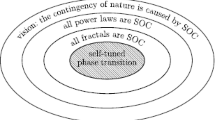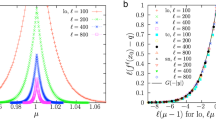Abstract
We develop a dynamical system approach for the Zhang model of self-organized criticality, for which the dynamics can be described either in terms of iterated function systems or as a piecewise hyperbolic dynamical system of skew-product type. In this setting we describe the SOC attractor, and discuss its fractal structure. We show how the Lyapunov exponents, the Haussdorf dimensions, and the system size are related to the probability distribution of the avalanche size via the Ledrappier–Young formula.
Similar content being viewed by others
REFERENCES
P. Bak, C. Tang, and K. Wiesenfeld, Self organised criticality: An explanation of 1/f noise, Phys. Rev. Lett. 59(4):381–384 (1987).
P. Bak, C. Tang, and K. Wiesenfeld, Self organised criticality, Phys. Rev. A. 38(1):364–374 (1988).
P. Bak, How Nature Works (Springer-Verlag, 1996).
P. Bàntay and M. Jànosi, Self-organization and anomalous diffusion, Physica A 185:11–18 (1992).
M. Barnsley, Fractals Everywhere (Academic Press, Boston, 1988).
C. Beck and F. Schloegl, Thermodynamics of Chaotic Systems (Cambridge Non Linear Science Series 4, 1993).
Ph. Blanchard, B. Cessac, and T. Krüger, A dynamical systems approach for SOC models of Zhang's type, J. Stat. Phys. 88:307–318 (1997).
Ph. Blanchard, B. Cessac, and T. Krüger, Ergodicity in one dimensional self-organized criticality, in preparation.
Ph. Blanchard, B. Cessac, and Krüger, Lyapunov exponents and critical exponents in self-organized criticality, in preparation.
R. Bowen, Equilibrium states and the ergodic theory of Anosov diffeomorphisms, Lect. Notes in Math. 470 (Springer-Verlag, Berlin, 1975).
B. Cessac, Ph. Blanchard, and T. Krüger, A Dynamical System Approach to Self-Organized Criticality (Mathematical Results in Statistical Mechanics, Marseille 1998, Word Scientific Singapore).
D. Dhar, Phys. Rev. Lett. 64:1613 (1990); D. Dhar and S. N. Majumdar, J. Phys. A 23:4333 (1990); S. N. Majumdar and D. Dhar, Physica A 185:129 (1992). D. Dhar and R. Ramaswamy, Phys. Rev. Lett. 63:1659 (1989).
Díaz-guilera, Dynamic renormalization group approach to self-organized critical phenomena, Europhys. Let. 26(3):177–182 (1994); Díaz-guilera, Noise and dynamics of self-organized critical phenomena, Phys. Rev. A 45(12):8551-8558 (1992).
J. P. Eckmann and D. Ruelle, Ergodic theory of strange attractors, Rev. of Mod. Physics 57:617 (1985); J. P. Eckmann, O. Kamphorst, D. Ruelle, and S. Cilliberto, Phys. Rev. A 34:4971 (1986).
F. Gantmacher, Theéorie des Matrices (Jacques Gabay É ditions).
K. Falconer, Techniques in Fractal Geometry (Wiley, 1997).
P. Gaspard, Chaos, Scattering and Statistical Mechanics (Cambridge Non-Linear Science Series 9, 1998).
J. E. Hutchinson, Fractals and self-similarity, Indiana University Mathematics Journal 30(5) (1981).
H. J. Jensen, Self-organized criticality emergent complex behavior, in Physical and Biological Systems (Cambridge Lecture Notes in Physics 10, Cambridge University Press, 1998).
F. Ledrappier and L. S. Young, The metric entropy for diffeomorphisms, Annals of Math. 122:509–574 (1985).
S. Luebeck, Large-scale simulations of the Zhang sandpile model, Phys. Rev. E. 56(2):1590–1594 (1997).
Ya. B. Pesin, Characteristic Lyapunov exponents and smooth ergodic theory, Russ. Math. Surveys 32:55–114 (1977).
L. Pietronero, P. Tartaglia, and Y. C. Zhang, Theoretical studies of self-organized criticality, Physica A 173:2244 (1991); R. Cafiero, V. Loreto, L. Pietronero, A. Vespignani, and S. Zapperi, Local rigidity and self-organized criticality for avalanches, Europ. Let. 129(2):111-116 (1995); L. Pietronero, A. Vespignani, and S. Zapperi, Phys. Rev. Lett. 72:1690 (1994); A. Vespignani, S. Zapperi, and L. Pietronero, Phys. Rev. E 51:1711 (1995).
M. Pollicott, Lectures on Ergodic Theory and Pesin Theory on Compact Manifolds (London Math. Soc., Lect. Notes Series 180, Cambridge University Press, 1993).
D. Ruelle, Thermodynamic Formalism (Reading, Massachusetts, Addison-Wesley, 1978).
J. Schmeling, Habilitation Thesis (Berlin, 1996).
Ya. G. Sinai, Gibbs measures in ergodic theory, Russ. Math. Surveys 27(4):21–69 (1972).
E. H. Speer, J. Stat. Phys. 71:61 (1993).
L. S. Young, Ergodic theory of differentiable dynamical systems. “Real and complex dynamics,” Ed. Branner and Hjorth, NATO ASI series, Kluwer Academic Publishers, 1995, pp. 293–336.
H. Y. Zhang, Scaling theory of self-organized criticality, Phys. Rev. Let. 63(5):470–473 (1988).
Author information
Authors and Affiliations
Rights and permissions
About this article
Cite this article
Blanchard, P., Cessac, B. & Krüger, T. What Can One Learn About Self-Organized Criticality from Dynamical Systems Theory?. Journal of Statistical Physics 98, 375–404 (2000). https://doi.org/10.1023/A:1018639308981
Issue Date:
DOI: https://doi.org/10.1023/A:1018639308981




